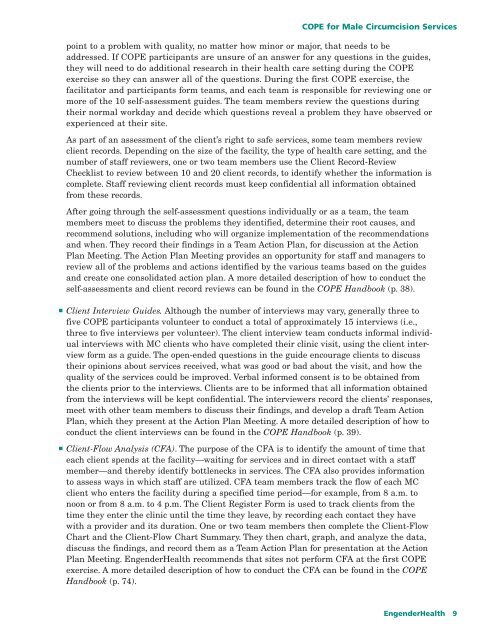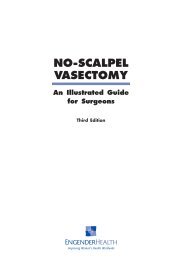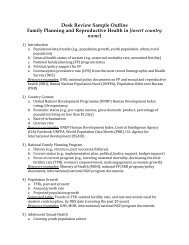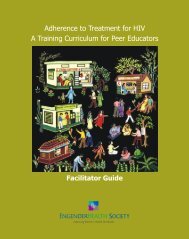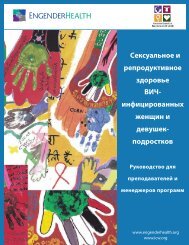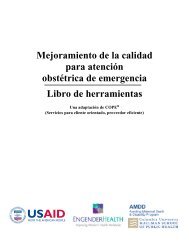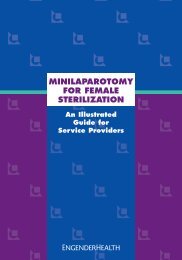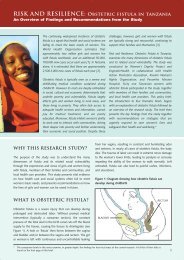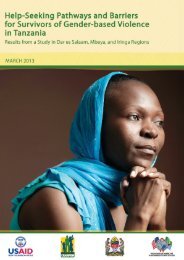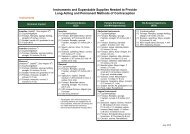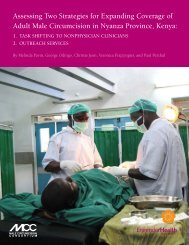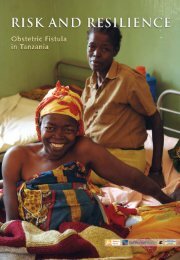COPE® FOR MALE CIRCUMCISION SERVICES - EngenderHealth
COPE® FOR MALE CIRCUMCISION SERVICES - EngenderHealth
COPE® FOR MALE CIRCUMCISION SERVICES - EngenderHealth
Create successful ePaper yourself
Turn your PDF publications into a flip-book with our unique Google optimized e-Paper software.
COPE for Male Circumcision Services<br />
point to a problem with quality, no matter how minor or major, that needs to be<br />
addressed. If COPE participants are unsure of an answer for any questions in the guides,<br />
they will need to do additional research in their health care setting during the COPE<br />
exercise so they can answer all of the questions. During the first COPE exercise, the<br />
facilitator and participants form teams, and each team is responsible for reviewing one or<br />
more of the 10 self-assessment guides. The team members review the questions during<br />
their normal workday and decide which questions reveal a problem they have observed or<br />
experienced at their site.<br />
As part of an assessment of the client’s right to safe services, some team members review<br />
client records. Depending on the size of the facility, the type of health care setting, and the<br />
number of staff reviewers, one or two team members use the Client Record-Review<br />
Checklist to review between 10 and 20 client records, to identify whether the information is<br />
complete. Staff reviewing client records must keep confidential all information obtained<br />
from these records.<br />
After going through the self-assessment questions individually or as a team, the team<br />
members meet to discuss the problems they identified, determine their root causes, and<br />
recommend solutions, including who will organize implementation of the recommendations<br />
and when. They record their findings in a Team Action Plan, for discussion at the Action<br />
Plan Meeting. The Action Plan Meeting provides an opportunity for staff and managers to<br />
review all of the problems and actions identified by the various teams based on the guides<br />
and create one consolidated action plan. A more detailed description of how to conduct the<br />
self-assessments and client record reviews can be found in the COPE Handbook (p. 38).<br />
■ Client Interview Guides. Although the number of interviews may vary, generally three to<br />
five COPE participants volunteer to conduct a total of approximately 15 interviews (i.e.,<br />
three to five interviews per volunteer). The client interview team conducts informal individual<br />
interviews with MC clients who have completed their clinic visit, using the client interview<br />
form as a guide. The open-ended questions in the guide encourage clients to discuss<br />
their opinions about services received, what was good or bad about the visit, and how the<br />
quality of the services could be improved. Verbal informed consent is to be obtained from<br />
the clients prior to the interviews. Clients are to be informed that all information obtained<br />
from the interviews will be kept confidential. The interviewers record the clients’ responses,<br />
meet with other team members to discuss their findings, and develop a draft Team Action<br />
Plan, which they present at the Action Plan Meeting. A more detailed description of how to<br />
conduct the client interviews can be found in the COPE Handbook (p. 39).<br />
■ Client-Flow Analysis (CFA). The purpose of the CFA is to identify the amount of time that<br />
each client spends at the facility—waiting for services and in direct contact with a staff<br />
member—and thereby identify bottlenecks in services. The CFA also provides information<br />
to assess ways in which staff are utilized. CFA team members track the flow of each MC<br />
client who enters the facility during a specified time period—for example, from 8 a.m. to<br />
noon or from 8 a.m. to 4 p.m. The Client Register Form is used to track clients from the<br />
time they enter the clinic until the time they leave, by recording each contact they have<br />
with a provider and its duration. One or two team members then complete the Client-Flow<br />
Chart and the Client-Flow Chart Summary. They then chart, graph, and analyze the data,<br />
discuss the findings, and record them as a Team Action Plan for presentation at the Action<br />
Plan Meeting. <strong>EngenderHealth</strong> recommends that sites not perform CFA at the first COPE<br />
exercise. A more detailed description of how to conduct the CFA can be found in the COPE<br />
Handbook (p. 74).<br />
<strong>EngenderHealth</strong> 9


